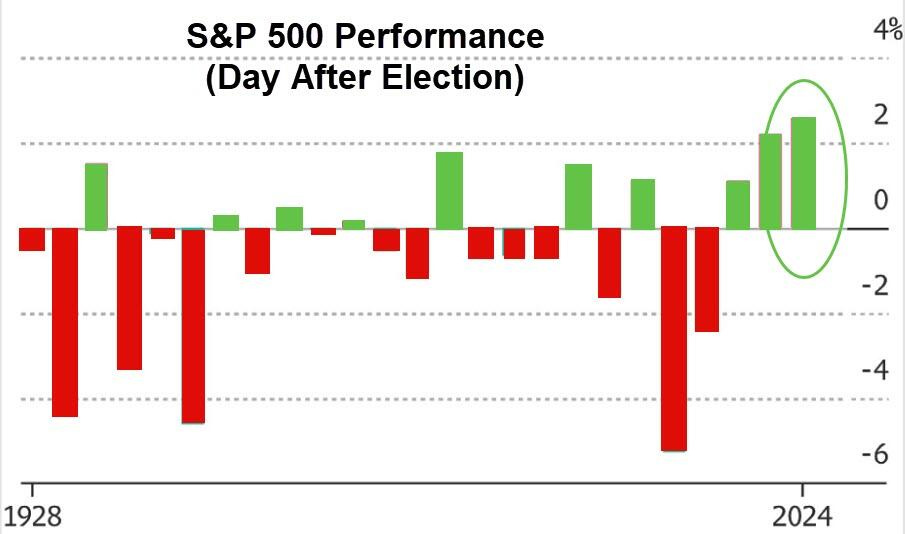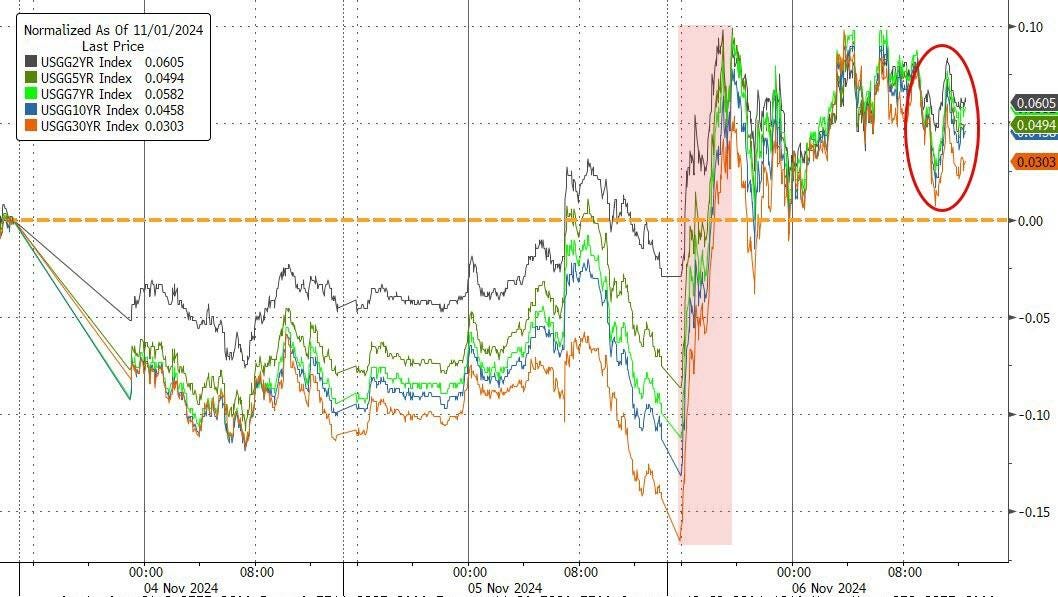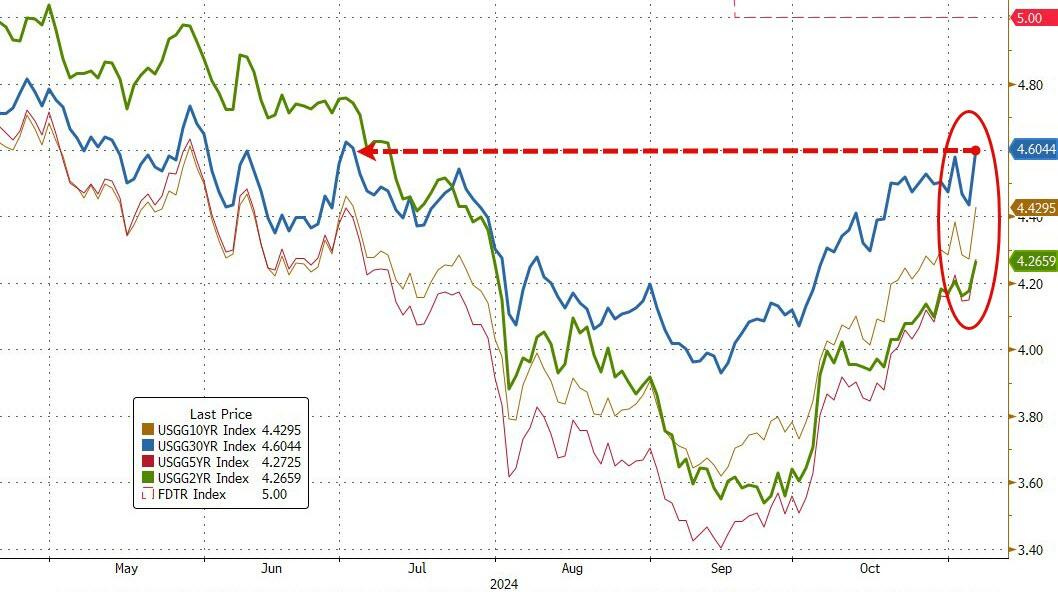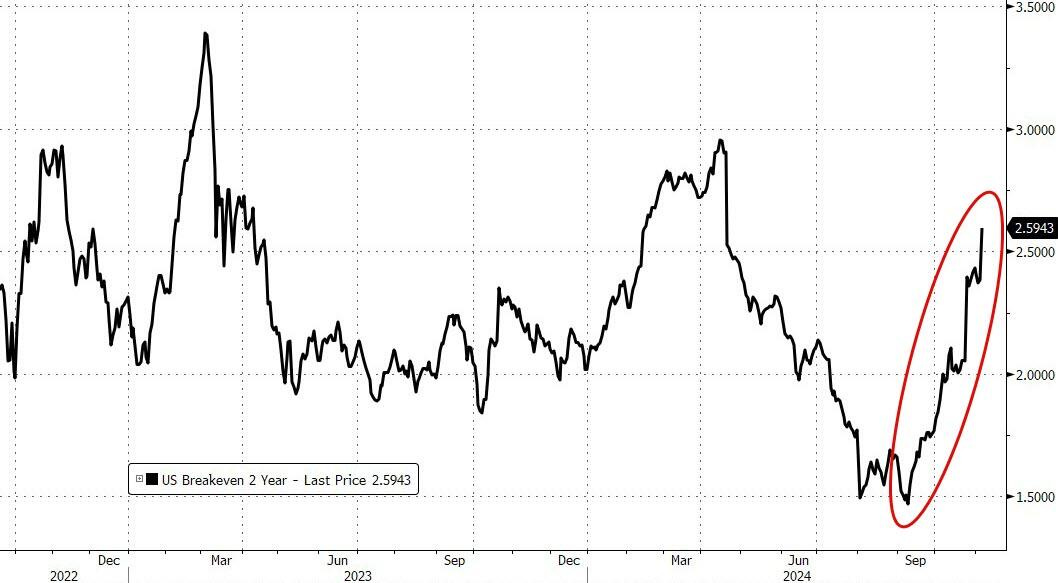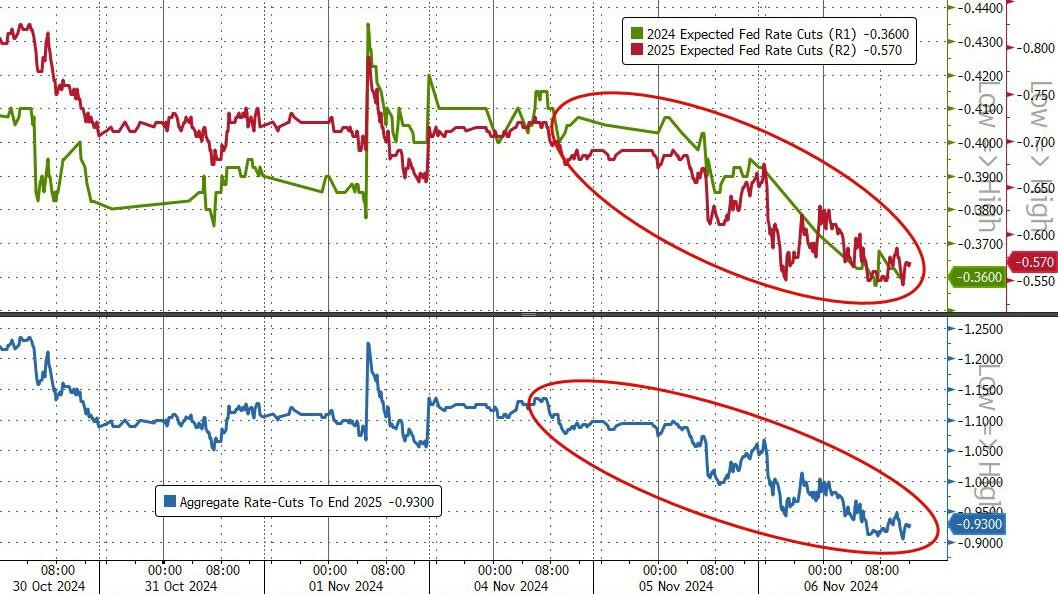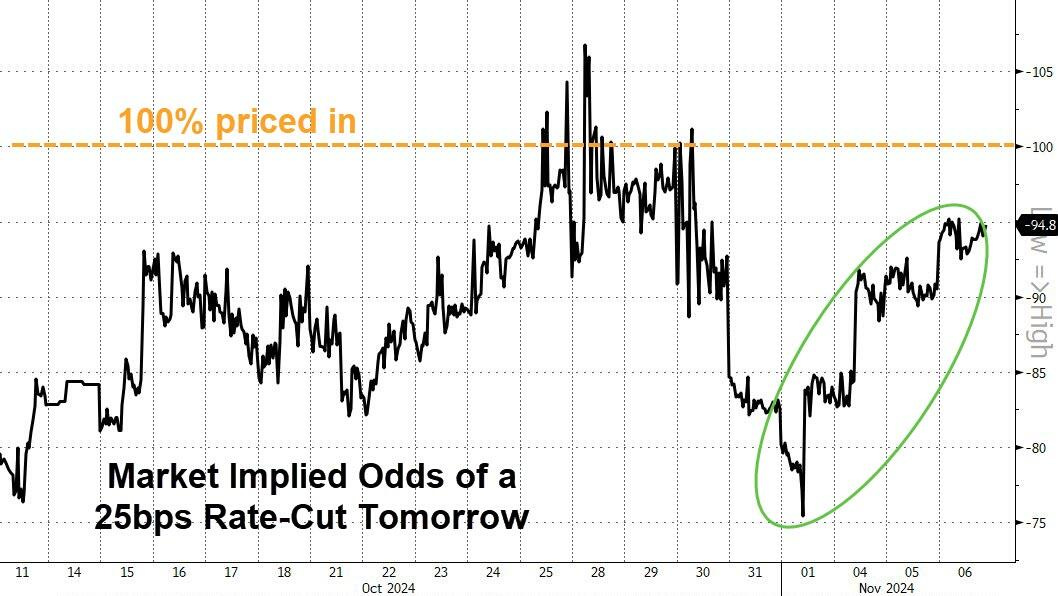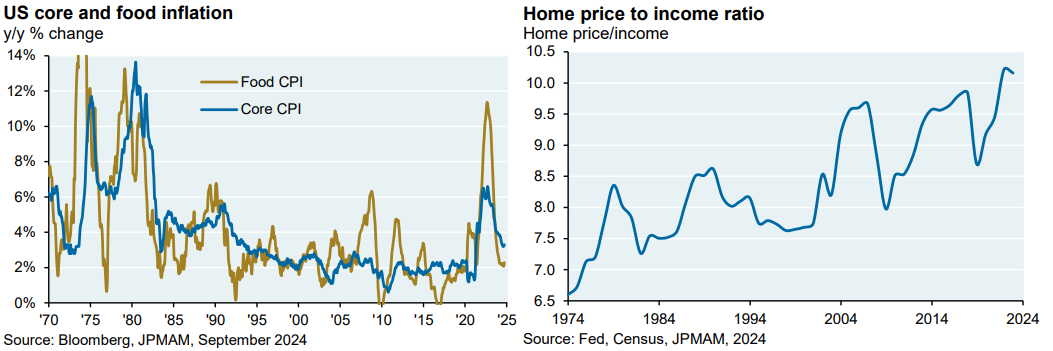while WE slept: US equity and bond yields calm ahead of rate CUT; 2yy vs 4.25%; 'bout that risk of (CRE)'double defaults'; "Kamilton" -Cembalest
Good morning … This week has been and remains one of the most consequential in as far as ‘event risk’ leading to volMAgeddon, in quite awhile.
Markets are currently taking a 5-minute break and smokin’ ‘em if they got ‘em (ie are aggressively UNCH) on heels of a record day in stonks …
… The S&P 500 (+2.53%) hit its 48th record high this year posting the best post-election day in its history. The 10yr Treasury yield rose +15.9bps, while the 30yr yield (+17.1bps) posted its biggest jump since March 2020 during the pandemic turmoil …
-DBs Jim Reid (below)
… and while all the action was in stonks and bonds, a quick look at the front end …
2yy DAILY: support (4.25% and a thick TLINE) is near …
… and as support is being tested, momentum (stochastics) rolling over into this afternoons rate cut … a decent setup for a ‘rental’ ?
… the weeks volMAgeddon set to continue today with the FOMCs rate CUT coming and with that in mind (and for some rate CUT / expectation visuals) I’ll move along with little else to add TO all that Mr. Markets is saying right here and now and for posterity sake …
ZH: 'Trump-Quake' Sparks Greatest Post-Election-Day Stock Market Gain In History
Where to start?
Today's 2.7% rally in the S&P 500 was the largest post-election-day gain in history...…Treasury yields soared on the Trump victory with the long-end lagging notably (30Y +17bps, 2Y +9bps) pushing everything higher on the week...
Source: Bloomberg
UST Yields are now back at their highest since early July...
Source: Bloomberg
Inflation Breakevens smashed higher on Trump's win - 2Y BEs at their highest since April...
Source: Bloomberg
Rate-cut expectations plunged with 2025 now pricing in just 57bps of cuts!!! The aggregate rate cut expectation from now until the end of the 2025 is less than 100bps (less than 4x25bp cuts)...
Source: Bloomberg
Tomorrow's 25bps rate-cut appears to be a lock (95% odds implied by the market)... but after that who knows?
… and as far as yesterdays supply of long bonds is / was concerned, well, build it (concession for long bond auction) and they came …
ZH: Yields Slide After Stellar 30Y Auction, But Then Blow Out Again
… but, but … ‘twas a stellar auction? In as far as rates having an impact and something that the kind folks at PiQ pointed out this morning in todays edition of
PiQ: The Overnight News Roundup
…The number of US borrowers in danger of defaulting a second time on commercial property loans is at the highest level in a decade, raising concerns that a bank practice known as “extend and pretend” is hiding growing systemic risk in the CRE sector. (FT)
… and a link, a visual and an excerpt
FT: … Banks face growing risk as double defaults on commercial loans mount
A bank practice known as ‘extend and pretend’ has delayed a write-off reckoning but may hide a growing systemic risk… “They are kicking the can down the road,” said Ivan Cilik, a principal with accounting firm Baker Tilly’s financial services group. “I think lenders are trying to work out the problems with these loans, but if rates don’t come down borrowers are not going to be able to make payments.”
Regulators are growing increasingly worried about the rise in loan modifications and whether they are distorting loan markets…
…“Banks ‘extended-and-pretended’ their impaired commercial real estate mortgages in the post-pandemic period,” the study’s others wrote, and warned the generous modifications could lead “to credit misallocation and a build-up of financial fragility.”
That is leading to a rise in double defaults…
… Ruh Roh … Team Rate CUT continues to watch and think ‘bout things just like this and this is where I will now reflect on and regret having said far too much (and too little all at the same time) and move along …
… here is a snapshot OF USTs as of 705a:
… HERE is what this shop says be behind the price action overnight…
… WHILE YOU SLEPT
… and for some MORE of the news you might be able to use…
IGMs Press Picks: November 07 2024
Reuters Morning Bid: Fed and BoE decide as US House awaited, Germany jarred
Finviz (for everything else I might have overlooked …)
Moving from some of the news to some of THE VIEWS you might be able to use… here’s SOME of what Global Wall St is sayin’ …
BNP: US equities: Party like it’s 2016
Trump 2.0: Our view coming into this week was that post-election we could see a spot rally, broadening participation down the market cap spectrum, and a volatility crush. This has manifested with one-day price action that unsurprisingly has resembled 2016 (Fig. 1).
Historically, we have seen a pattern of de-risking into US elections and then money put to work post the event risk. Following a reassuring Q3 earnings season, with the Fed cutting rates and US macro data consistent with a soft landing, we see little reason to expect a deviation from that playbook now. In 2016, the defensive sectors that fell post Election Day subsequently traded sideways for several months. The cyclicals that outperformed immediately post the election continued to trend higher. The larger magnitude of the one-day rally in cyclicals following the 2024 result may have pulled forward some of the subsequent outperformance. We see scope for a further cyclical trend higher, but perhaps from here with a smaller magnitude and slower pace than in 2016.DB: Trump sweep trades in US rates
On President Trump’s decisive victory and Republican electoral strength more broadly, the move in US rates thus far has been in line with our expectations on a Trump sweep outcome, where we had 2y and 10y UST yields up 11bp and 18bp, respectively (vs. realized thus far of 9bp and 17bp).
The key question for US rates markets now is the policy mix ahead, which will depend critically on whether Republicans keep the House. As we and others have flagged, this has important implications for the timing and scale of fiscal and tariff policies, with more early emphasis on the latter if the House does not stay red.
Given what we’ve seen thus far, it seems reasonable to place a very high likelihood on the sweep outcome. In terms of what that could mean for the level of US yields, we’ll be reviewing our forecast as the picture evolves. But as we noted, a 10y UST yield of 4.6% or higher seems sensible under a sweep, arguably with significant upside risk as the market contemplates a more sweeping regime shift, perhaps best framed as a return to the pre-GFC world of higher neutral and higher term premia.
Against this backdrop, trades with momentum that should do well on sweep are:
Wider inflation swaps: Inflation should be lifted by both fiscal and tariffs (see here). A couple weeks ago we recommended long 1y2y inflation as an asymmetric trade, with an indicative target of 2.75% (vs. current of 2.65%).
Higher term premia: Term premia should rise on more stimulative fiscal policy. And while exposed to tariffs, those effects are less clear and likely dominated by fiscal under a sweep. This comes on top of a view that term premia (TP) have been structurally too low regardless of the election outcome. Good expressions for this view are long 5s10s TP (5s10s + 20% 2y short), in UST or swaps, or 2y3y-5y5y steepeners; for 5s10s TP in UST, our baseline forecast – pre-election and prior to the recent spate of better US economic data – was 108bp vs. current of 101bp.
Higher neutral rate: more fiscal stimulus policy should boost the neutral rate. At 3.82%, SFRZ5 is priced right on top of the neutral fed funds rate target of 3.75-4% we penciled in for a Trump sweep, but we see risks to that as tilted to the upside and those futures should carry some positive risk premium.
Earlier Fed pause/skip: the better the prospects for a sweep and resulting fiscal, the more likely is a Fed pause. This week’s meeting is a lock, but as discussed here the case beyond is murkier. Pay Jan FOMC looks good as it currently prices close to 30bp of post-November meeting cuts.
DB: Post election: Fiscal fuel trumps trade tensions for Fed
The election of Donald Trump and the potential for a Republican sweep (at the time of writing, Republicans have taken control of the Senate but the House remains uncertain) promise material shifts in the economic policy landscape. In this note, we build on our recent analysis (see "Election outcomes: Potential growth and deficit impacts" and "Looking beyond the next 25bps to '25: The Fed outlook post election") and detail how our outlook may shift in light of the election outcome. As we await clarity on the House, this note is illustrative of possible upcoming forecast revisions rather than a formal change to our outlook.
… Given the initial positive demand shock followed by an adverse supply shock that lifts inflation but still leaves growth relatively resilient, this outcome would be hawkish for the Fed. We could see the Fed ending 2024 with a Fed funds rate of 4.3% and then undertaking one additional rate cut in 2025 (i.e., Fed funds at 4.1% yearend 2025), before cutting rates to 3.6% by end 2026, near our neutral rate assumption of 3.5-3.75%, under a Trump divided scenario.
DB: Early Morning Reid
…Looking now at the market reaction to the US election result. Let’s start with some highlights. The S&P 500 (+2.53%) hit its 48th record high this year posting the best post-election day in its history. The 10yr Treasury yield rose +15.9bps, while the 30yr yield (+17.1bps) posted its biggest jump since March 2020 during the pandemic turmoil. In the meantime, the dollar had its strongest day against the euro since 2016 (+1.89%), whilst Bitcoin (+6.50%) closed at an all-time high of $74,507. So it was a historic day that we’ll no doubt benchmark against for some time when it comes to market movements…
JPMs Mike Cembalest: EYE ON THE MARKET
“Kamilton”: the 2024 election and who tells your story
November 6, 2 024… In any case, exit polls show that the GOP message on inflation dominated. Some history: in search of a new paradigm to replace neoliberalism, Biden/Harris chose the populist fiscal approach of reaching full employment as fast as possible. A Magna Carta of this populist fiscal movement is a 2020 memo from the Hewlett Foundation which reads like a road map for crossing a bridge that’s actually out of service: “If economic developments over the past decade show anything, it is that there is greater headroom for spending without causing undue inflation. Acknowledging this creates space for a new consensus permitting governments more room to spend on efforts that boost aggregate demand without worrying about inflation quite so frantically” 2 . Actually, Biden and Harris should have been a lot more frantic. The subsequent inflation surge was the worst since the late 1970’s, and was accompanied by the worst housing affordability data on record as well (measured by home price to income ratios)…
… The 10 year US Treasury has already been behaving very strangely in the wake of Fed easing, as shown in the next chart. Part of the reason: inflation expectations have been rising again. If deportations cause a U-turn in the lowest quartile of wage growth, or if Trump’s other plans prove to be inflationary, the Fed may have to reconsider its easing plans. The most important indicator to watch will be the 10-year Treasury, a bellwether for Trump’s tariff/deportation/loose fiscal agenda vs the supply side benefits of a less regulated economy.
Wells Fargo: The 2024 U.S. Elections: Economic Implications
Summary
…Federal Reserve: Our current forecast looks for the FOMC to cut its target range for the federal funds rate, currently 4.75%-5.00%, to 3.00%-3.25% by the end of next year. However, the FOMC may not want to ease policy by that much if new tax cuts and tariffs cause inflation to shoot higher over the next couple of years. Thus, we think the risks to our fed funds rate forecast are skewed to the upside (i.e., less easing next year than we currently project).
The FOMC's reaction function likely would be more hawkish in response to higher inflation from tax cuts than from tariffs. Tighter monetary policy is an effective method for slowing demand growth, but it cannot do much to combat inflationary pressure from a supply shock such as tariffs…
UBS: Voting in the aisles of WalMart
Every pundit claims they know the reason for the US election outcome. This pundit is no different. In exit polls, Republican voters’ biggest concern was the economy and 75% of US voters said inflation was a hardship this year. Three years of durable goods price deflation are not noticed by voters, who focus on price levels of high-frequency purchases (like food). The election may have been won and lost in the aisles of Walmart, over the price of a Snickers bar.
Trade taxes raise US consumer prices, but that inflation will skew towards less visible durable goods prices. Inflation may not deter tariffs. The Federal Reserve is supposed to deal in inflation realities, which justify a rate cut today. Headline consumer price inflation has fallen one percentage point this year, raising real rates.
China’s October export data was a lot stronger than expected. There are rather implausible claims this is in anticipation of trade tariffs. China’s officials are likely under pressure to meet their 5% growth target. Note that part of China’s exports never leave China, so China exports 16% more to the US than the US imports from China.
Germany and Ireland are heading to general elections. Economists’ main thought is “could this not have waited a week?”.
Wells Fargo: Global Takeaways of the U.S. Election
Summary
In this report, we examine some thematic and global takeaways from the U.S. election. We view a second Trump administration—and more specifically his proposed tariff policies— as a catalyst for further deglobalization and global economic fragmentation. Tariffs could also act as an inflection point for China to approach stimulus efforts differently, while the nature of U.S. involvement in foreign affairs also has scope to take a new path relative to the Biden administration Lastly, we maintain our view for a stronger dollar over the medium term, and believe any attempts from Trump to manufacture dollar weakness will prove to be futileYardeni: Trump 2.0 and the Financial Markets
… Treasury yields jumped as the yield curve steepened. The Bond Vigilantes are pricing in higher growth, inflation, and government borrowing. The 10-year yield rose 15bps to around 4.40% and the 30-year yield rose 18bps to roughly 4.60% today (chart).
… And from Global Wall Street inbox TO the WWW …
Bloomberg: Bond Traders Net Millions on Bearish Option Bets After Trump Win
(Bloomberg) -- In the market for Treasury options, speculators appear to be cashing in on bets placed a few weeks ago that would benefit from a jump in yields, and are likely netting millions of dollars in profits…
… The October bets were part of so-called Trump trades anticipating that a victory by the Republican former president would usher in steeper tariffs and fiscal stimulus, spurring quicker economic growth and inflation and a wave of additional Treasury issuance. The wagers also encompassed bets that the dollar and US stocks would gain, which also came to fruition Wednesday.
The options wagers established last month were targeting, in part, an increase in the 10-year yield to 4.5%, and as bonds slumped on Wednesday, the rate on the maturity climbed to just below that level. The 30-year yield, meanwhile, rose the most since 2020, peaking at 4.68% and approaching the 4.75% target of the October options bets.
The block trades seen through midday Wednesday potentially netted roughly $18.5 million in profit combined and amounted to a partial unwinding of the wagers placed on Oct. 11. Trading in many of these contracts is anonymous, making it difficult to identify the firms involved.
LPL: Unpacking the Treasury Rout Trifecta Post Trump Victory
…And we won’t have to wait long for the Fed's response as it kicks off its two-day meeting today where it is highly likely that the Federal Open Market Committee (FOMC) will cut short-term interest rates on Thursday. But market pricing for a December rate cut has come down to roughly a 70% chance of a cut (down from 85% yesterday). And more importantly, the total number of interest rate cuts continues to decline. At one point, markets were expecting 10 total interest rate cuts throughout 2025, which would take the fed funds rate down to 2.9%. Currently, markets are expecting only four more cuts throughout 2025 and a fed funds rate of 3.75%. If markets are right, that likely means long-term Treasury yields could settle into a higher range than what we were expecting and higher bond yields in general. But the good news is that starting yields are highly correlated to future returns, so investors can use the recent back-up in yields to add to high-quality fixed income, especially for those clients with excess cash holdings.
WolfST: Longer-term Treasury Yields & Mortgage Rates Explode, Yield Curve Un-Inverts Further as Bond Market Gets Spooked
Going to further crush demand for existing homes. Bondholders feel the pain.
…The 30-year Treasury yield spiked by 20 basis points this morning, to 4.64%, the highest since May 31 May 30. Since the Fed’s rate cut on September 18, it has shot up by 68 basis points.
So all the bond market needs to get spooked further are more rate cuts?
… THAT is all for now. Off to the day job…



